Egads, I forgot to post tour photos from our latest tour, which was Number 50 in a series that goes all the way back to June 1st, 1999, when we did a 5 hour tour on Brooklyn’s Broadway from the East River to Broadway Junction in East New York.
This tour, on Saturday, November 12th, was the 8th and final ForgottenTour of the season. Before we resume in spring 2012, I have several ForgottenTours Indoors planned at the Greater Astoria Historical Society. Stay tuned for announcements. We walked Hudson River Park from South Ferry all the way to the Intrepid aircraft carrier museum. In a fall that was mostly warm except for a pre-Halloween snowstorm, it was rather chilly.
This tour was extensive, with about 60 stops scattered along a 5 mile route. These are just a few of the highlights.
WORLD FINANCIAL CENTER. The World Financial Center is a complex of buildings across West Street from the World Trade Center site in Lower Manhattan in New York City, overlooking the Hudson River. This complex is home to offices of companies including Merrill Lynch, RBC Capital Markets, Nomura Group, the Wall Street Journal, American Express, Dow Jones and others. The entire complex is owned by Brookfield Properties, except for the space occupied by American Express (which American Express owns). The complex also serves as the corporate headquarters for Brookfield Properties, which has its headquarters in Tower Three.
Designed by César Pelli, with Adamson Associates, the complex was built by Olympia and York between 1985 and 1988 onlandfill used to build Battery Park City. The fill material came from dirt excavated during the building of the World Trade Center, as well as garbage, dirt and debris. wikipedia
COLGATE CLOCK. (We caught sight of this across the Hudson — we stayed on the Manhattan side).
The familiar octagonal Colgate clock, facing Manhattan, dates back to 1924 when it was set in motion on December 1 by Jersey City’s Mayor Frank Hague. Located on the former site of Colgate-Palmolive & Company, it is a reminder of the time when factories dominated the Jersey City’s waterfront. The clock’s design was inspired by the shape of a bar of Octagon Soap, first manufactured by Colgate as a laundry cleanser.
The Colgate’s Soap and Perfumery Works, later Colgate-Palmolive Peet, was founded by William Colgate in 1806. He began as a manufacturer of starch, soap and candles with a shop on John and Dutch Streets in New York City. When he moved his company to Paulus Hook (Jersey City) in 1820 to produce starch, it was referred to as “Colgate’s Folly.” The company instead flourished and had a sizable complex in Jersey City by 1847. It made chemically produced soap and perfume but eventually gave up perfume production. Upon the death of William Colgate in 1857, his son Samuel reorganized the company as Colgate & Company. It took on brand products such as Cashmere Bouquet, perhaps the first milled perfumed soap, and revolutionized dental care with toothpaste sold in jars in 1873. It also packaged toothpaste in a “collapsible” tube in 1896.
Overlooking the Hudson River, the octagonal Colgate clock and signage perched on a company structure remained unaltered until 1983. The signage “Soaps-Perfumes” was removed and a toothpaste tube, advertising one of Colgate’s best selling products, took its place. Two years later and after 141 years in Jersey City, Colgate decided to leave, citing the need for improved facilities that its original manufacturing complex could not provide. The entire complex was razed, and the clock, without the toothpaste tube, was lowered to ground level as a freestanding icon on the future Goldman Sachs property, where it stood for fifteen years. The 24-acre site became part of the redevelopment of the Jersey City waterfront at Exchange Place that began in the early 1990s. wikipedia
Greater Astoria co-host Rich Melnick at the NYPD MEMORIAL at World Financial Center.
Unfortunately as I write this in late December, one more name, Peter Figoski, must be added to the NYPD Memorial.
The NYPD Memorial Wall located in Battery Park City within yards of the World Financial Center has the names of over 500 members of the NYPD killed in the line of duty. Many were added after 9/11/01.
One of the names is that of Lieutenant Joseph Petrosino.
When he joined the Police Department in 1883, Petrosino was the city’s shortest officer, at five feet and three inches tall. Police Commissioner Theodore Roosevelt personally promoted him to Sergeant of Detectives in 1895. While investigating anarchists in the United States, Petrosino warned President McKinley of threats against his life; however, the warning was not heeded and the President was assassinated in 1901.
Within ten years, Petrosino was named lieutenant and given command of the new Italian Squad, a unit created to combat the crime organization known as the Black Hand. Under his leadership, several thousand arrests were made, and more than 500 offenders were sent to prison. Crimes against Italian-Americans dropped by fifty percent. Petrosino was killed while on assignment to Palermo, Sicily.
When his body was returned to New York, thousands of mourners formed a funeral procession which marched from Little Italy to Calvary Cemetery in Queens. Lt. Petrosino was the only New York police officer who had died in the line of duty outside the United States.
The IRISH HUNGER MEMORIAL, designed collaboratively by artist Brian Tolle, landscape architect Gail Wittwer-Laird, and 1100 Architect, is located on a one-half acre site at the corner of Vesey Street and North End Avenue in the Battery Park City neighborhood of Manhattan in New York City, and is dedicated to raising awareness of the Great Irish Famine that killed up to a million in Ireland between the years 1845 and 1852. The memorial was dedicated on July 16, 2002. It is a uniquely landscaped plot, which utilizes stones, soil, and native vegetation brought in from the western coast of Ireland. The memorial contains stones from all of the different counties of Ireland. The memorial also incorporates an authentic rebuilt Irish cottage of the 19th century. wikipedia
It wasn’t part of the tour, but one of the Battery Park City folks had their pet parrot out for a squawk.
JERSEY CITY POWERHOUSE. Cheating here again just a bit (we saw if from across the Hudson).
From 1908 to 1929, rail cars would roll through towering iron doors into the huge brick building near the Jersey City waterfront and unload coal to generate electricity for the Hudson & Manhattan Railroad linking New York and New Jersey, now known as the PATH.
Since then, however, the Romanesque Revival structure has been largely abandoned, a colossal eyesore amid luxury skyscrapers built more recently by Donald Trump and others on one of the richest stretches of New Jersey’s Hudson River Gold Coast.
But the Washington Street Powerhouse may finally be re-energized. Under a plan recently authorized by the Port Authority of New York and New Jersey, the bi-state agency will deed its 55-percent stake in the Powerhouse to Jersey City, the building’s co-owner. Along with a private partner, the Cordish Company of Baltimore, the city plans to redevelop the building into a retail, entertainment and gallery space anchoring the city’s Powerhouse Arts District, an area of warehouses and cobblestone streets where zoning encourages artists to live and work.
TENDER LILAC is a 1933 former lighthouse tender that brought supplies to lighthouses and maintained buoys for the U.S. Lighthouse Service and the U.S. Coast Guard. Decommissioned in 1972, she is now owned by the non-profit Lilac Preservation Project. She is the oldest lighthouse tender in America and the only steam-powered tender to survive with her steam engines intact. LILAC is listed on the National Register of Historic Places and eligible to become a National Historic Landmark.
HUDSON RIVER PIER REMNANTS. Above: Pier 32, formerly Moore-McCormack Shipping. The Moore-McCormack Lines was a series of companies operating as shipping lines, operated by the Moore-McCormack Company, Incorporated later Moore-McCormack Lines, Incorporated and simply Mooremack, founded in 1913 in New York, USA. From a small start with one ship, SS Montara, inaugurating a run from the USA to Brazil, the shipping line expanded to become a major US line operating around the world.
Moore-McCormack’s original offices were at 29 Broadway (now still a general office building), but were moved in 1919 to 5 Broadway.
The McLean Lines bought out Mooremack in December 1982, after the energy crisis of the late 1970s and early 1980s meant that shipping costs had become unsustainable for the company. wikipedia
JANE WEST HOTEL, Jane and West Streets. The American Seamen’s Friend Society Institute, at Jane and West Streets, was built in 1910 by architect William Boring and has also been known as the Jane West Hotel and the Hotel Riverview. Its octagon tower once held a beacon that could be seen from Hudson River shipping. In 1912, it hosted survivors from the Titanic, which was to be berthed nearby at the Cunard piers. It has recently [2008] been purchased for $34M by a partnership including hospitality impresario Sean McPherson, who are transforming it into a tourist hostel — not without an outcry from the current occupants who are protesting pending evictions.
WEST STREET’S NEW ARCHITECTURE. IAC Building (foreground), 100 11th Avenue (rear).
Los Angeles-based architect Frank Gehry’s first major project was the Interactive Media Building completed in 2008, its outline built to resemble a masted sailing ship. Interactive Media president, Barry Diller, and his wife, fashion designer Diana Von Furstenberg, each work in the area and have donated large contributions to the High Line project.
100 11th Avenue was nicknamed by its architect Jean Nouvel as a “vision machine,” this new expensive condo development features over 1,650 differently-sized opaque glass windows on its exterior. Some of the more expensive apartments are priced at $40 million.
PIER 54 SUPERSTRUCTURE. Pier 54 was one of a set of piers running along the West Side of Manhattan from West 12th to 23rd Street that made up the Chelsea Piers that was completed in 1910. It was designed by the architectural firm of Warren and Wetmore, which also designed Grand Central Terminal. The piers replaced a hodgepodge of run-down waterfront structures with a row of grand buildings embellished with pink granite facades.
In April 1912, following the Titanic sinking the RMS Carpathia picked up survivors. The ship first went to the White Star piers where it discharged the Titanic’s lifeboats that had been brought aboard before coming back to Pier 54 to discharge the passengers.
The RMS Lusitania left the port in 1915 before being torpedoed and becoming the rallying cry for American involvement in World War I. The pier continued luxury liner service until the 1930s when a luxury liner row was built between West 44th and West 52nd Street to handle larger liners.
The pier was used for troop ships during World War II. After the war it was used as part of the W. R. Grace and Company and United States Lines freight operations.
In the 1980s plans were made to demolish it (and the rest of the Chelsea Piers) for the Westway highway. In 1991 the structure was torn down although it remained an open air pier and the entrance archway was preserved. A faded sign on the archway notes the name of the merged Cunard White Star line. wikipedia
FIREBOAT JOHN J. HARVEY, PIER 66A (West 27th). The John J. Harvey is a fireboat formerly of the New York City Fire Department in New York City, famed for returning to service following the September 11, 2001 attacks.She is among the most powerful fireboats ever built, capable of pumping up to 18,000 gallons of water a minute.
Launched in 1931, the John J. Harvey had a distinguished career in the FDNY until her retirement in 1994. She was named for marine fireman John J. Harvey, killed when a ship exploded during a fire. Among the marine fires at which she assisted were the Cunard Line pier fire in 1932, the burning of the Normandie in 1942, the ammunition ship SS El Estero in 1943, and the collision of the Alva Cape and Texaco Massachusetts oil tankers in 1966. Her official designation at the end of her career was Marine 2.
The Harvey was sold, at auction, in 1999, to a private consortium of marine preservationists determined to prevent her from being scrapped. In June 2000 she was added to the National Park Service‘s National Register of Historic Places. Her current owners have thoroughly restored her, and host frequent free trips on the river. wikipedia
TITLE CARD: ForgottenFans pose in front of the Starrett-Lehigh Building, West 27th Street. A huge freight terminal and warehouse occupying an entire block from 26-27 Streets and 11 and 12 Avenues completed in 1932. The Lehigh Valley Railroad could once enter the building, with its cars accessing floors via elevator (trucks use them now). Traces of carfloats and tracks can still be seen at the waterfront. This building is a forerunner of the International Style glass walled design popular later in the century.
USS INTREPID, docked at West 46th Street. Also known as The Fighting “I”; is one of 24 Essex-class aircraft carriers built during World War II for the United States Navy. She is the fourth US Navy ship to bear the name. Commissioned in August 1943, Intrepid participated in several campaigns in the Pacific Theater of Operations, most notably the Battle of Leyte Gulf. Decommissioned shortly after the end of the war, she was modernized and recommissioned in the early 1950s as an attack carrier, and then eventually became an antisubmarine carrier. In her second career, she served mainly in the Atlantic, but also participated in the Vietnam War. Her notable achievements include being the first US aircraft carrier to launch aircraft with steam catapults, and being the recovery ship for a Mercury and a Gemini space mission. Because of her prominent role in battle, she was nicknamed “the Fighting I”, while her often ill-luck and the time spent in dry dock for repairs earned her the nickname “the Dry I”.
Decommissioned in 1974, in 1982 Intrepid became the foundation of the Intrepid Sea-Air-Space Museum in New York City. wikipedia
That’s just a select few of our stops on this tour!
Special thanks to Jessica DuLong of the Fireboat Harvey

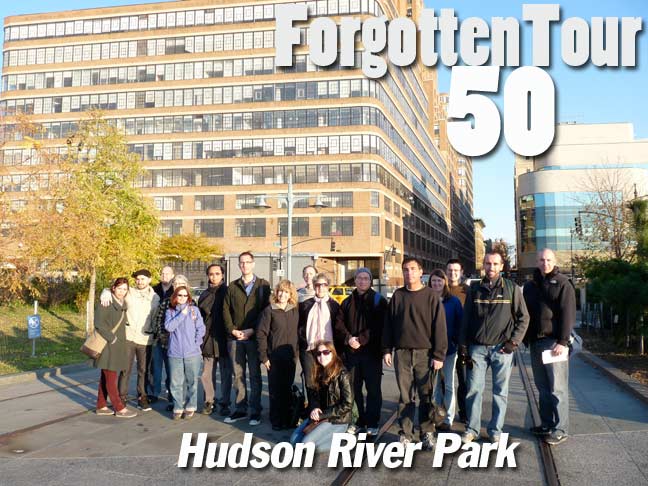

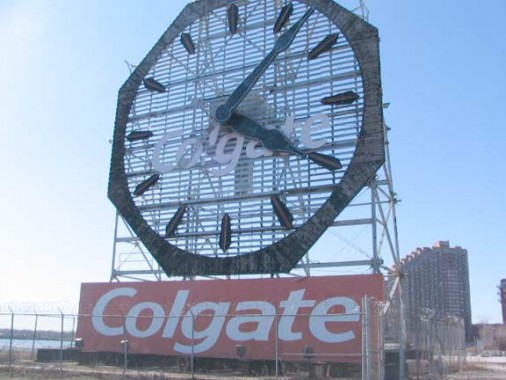


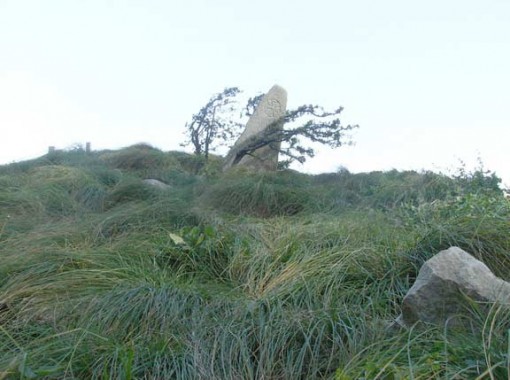
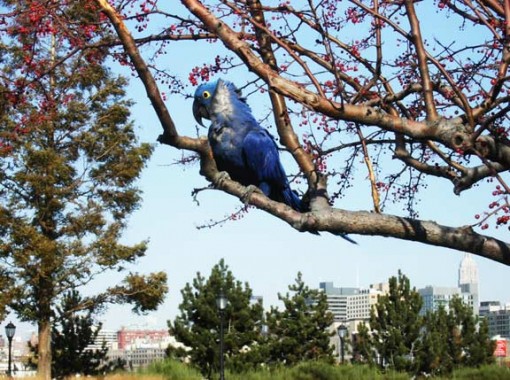

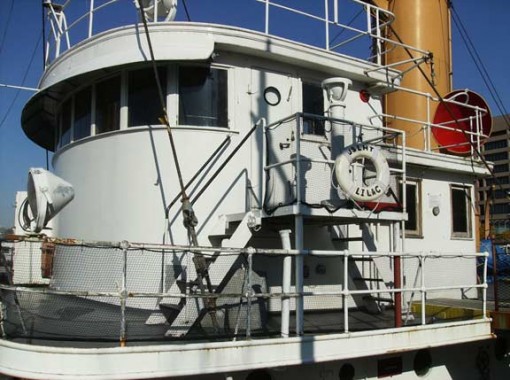
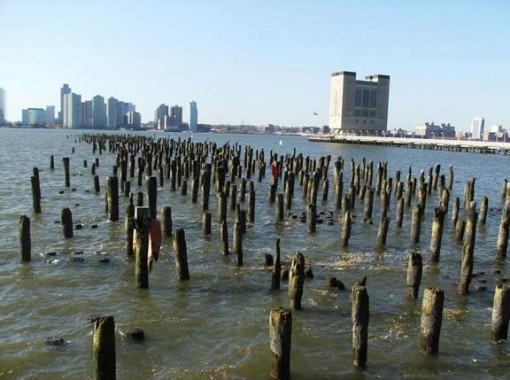




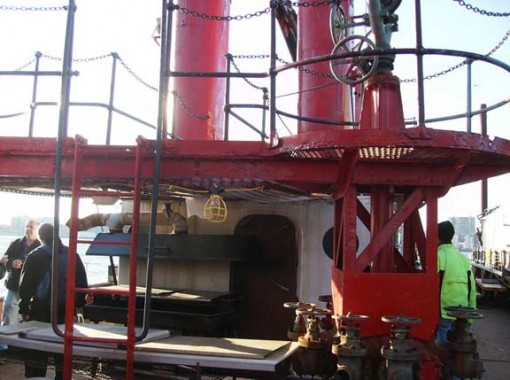
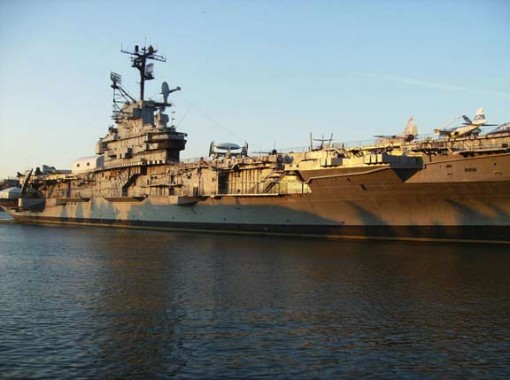
7 comments
The title card was shot on the entrance to the only Howe Truss float bridge left in Manhattan that once served the B&O Railroad. The railyard was next to the Starret-Lehigh building of the Erie RR and served NY’s port to receive and send out thousands of freight cars loaded with merchandise. Almost all freight into NYC was moved this way pre-1973. After that, it was over. Some of these freight buidings still exist under different uses like those of the High Line.
Mr. Trump purchased the land south of 79th street which was the NY Central yards to build his Trump city. The remnants of a screw jack float bridge can still be seen at waters edge from the West side highway.
Re: The late Lt. Petrosino: I believe that around 1960 his career was memorialized in the film “Black Hand” (?) starring Ernest Borgnine. It wasa B film which I vaguely remember seeing on TV (Million Dollar Movie?) too many years ago.
I believe it was “Pay or Die”
Dave
I believe you’re right. It’s been so long I’m surprised I remember even as much as I do
Most of the land fill for the financiial center came from the ocean. It took almost two years of sand dredging and then dumping the dredged material on the Hudson River floor. It also took about a year to remove the piers that were there. The Pier pilings were loaded onto what looked old steel sailing ships (one still had the bow spirit in place). After these things were loaded the scows werew taken out into the ocean and the piles were set on fire with the ashes dumped into the ocean.
I also saw barges floated in containing stones. These stones were dumped intot he river and uses as a base for the sand that was brought in.
[…] since Forgotten NY‘s Forgotten Tour 50 (blog entry coming soon), I’d been a bit obsessed with the now-demolished Miller Highway. […]
Let’s do some old Murder & Mayham in old NY !!!